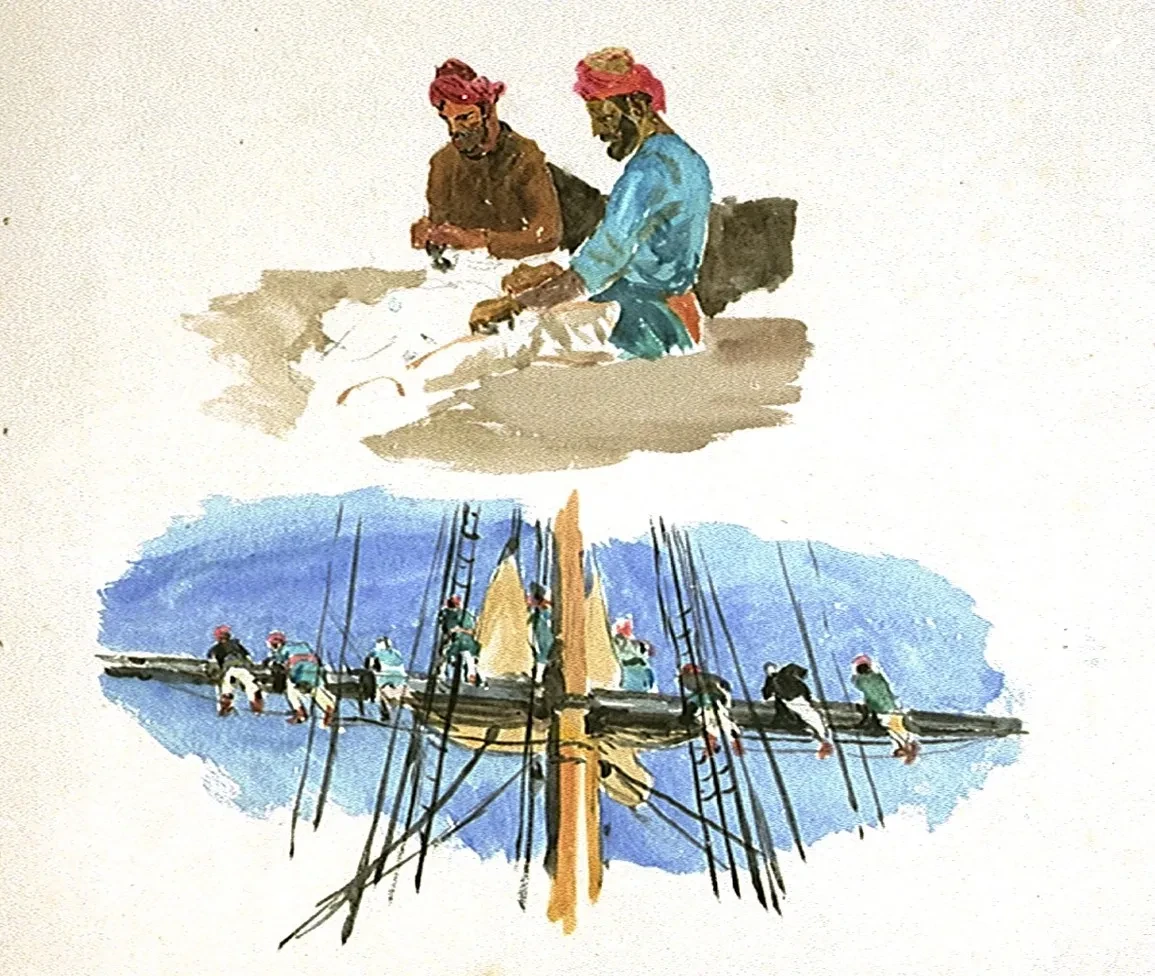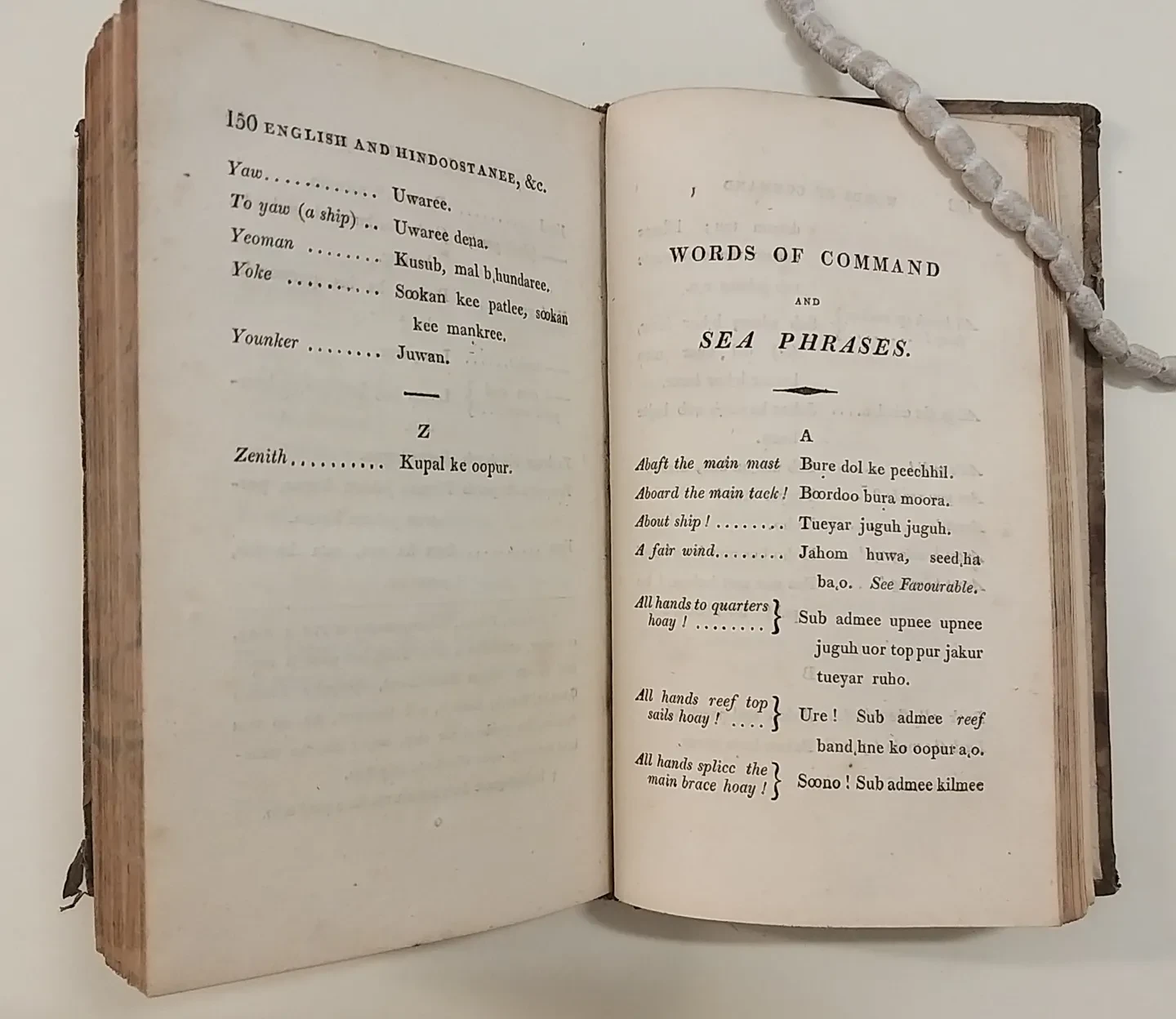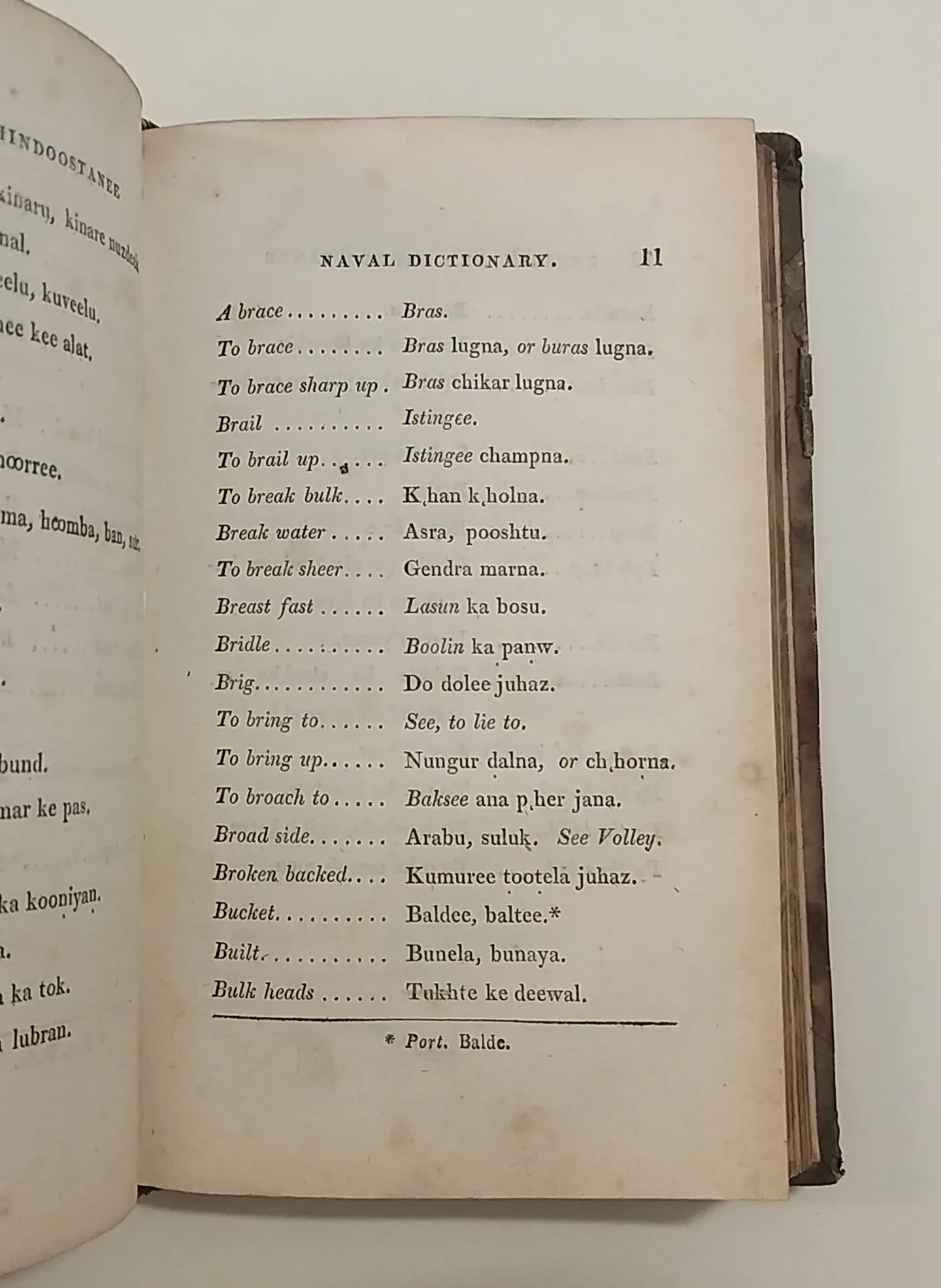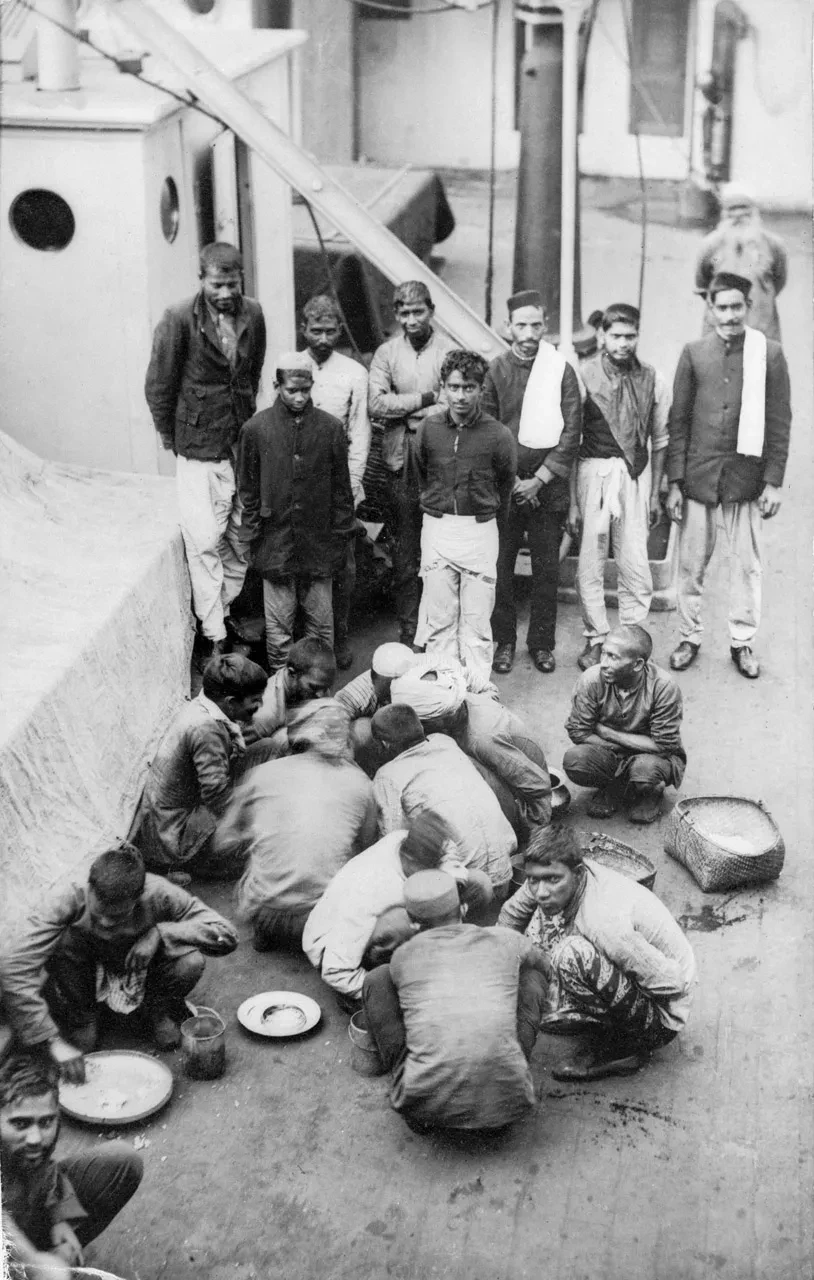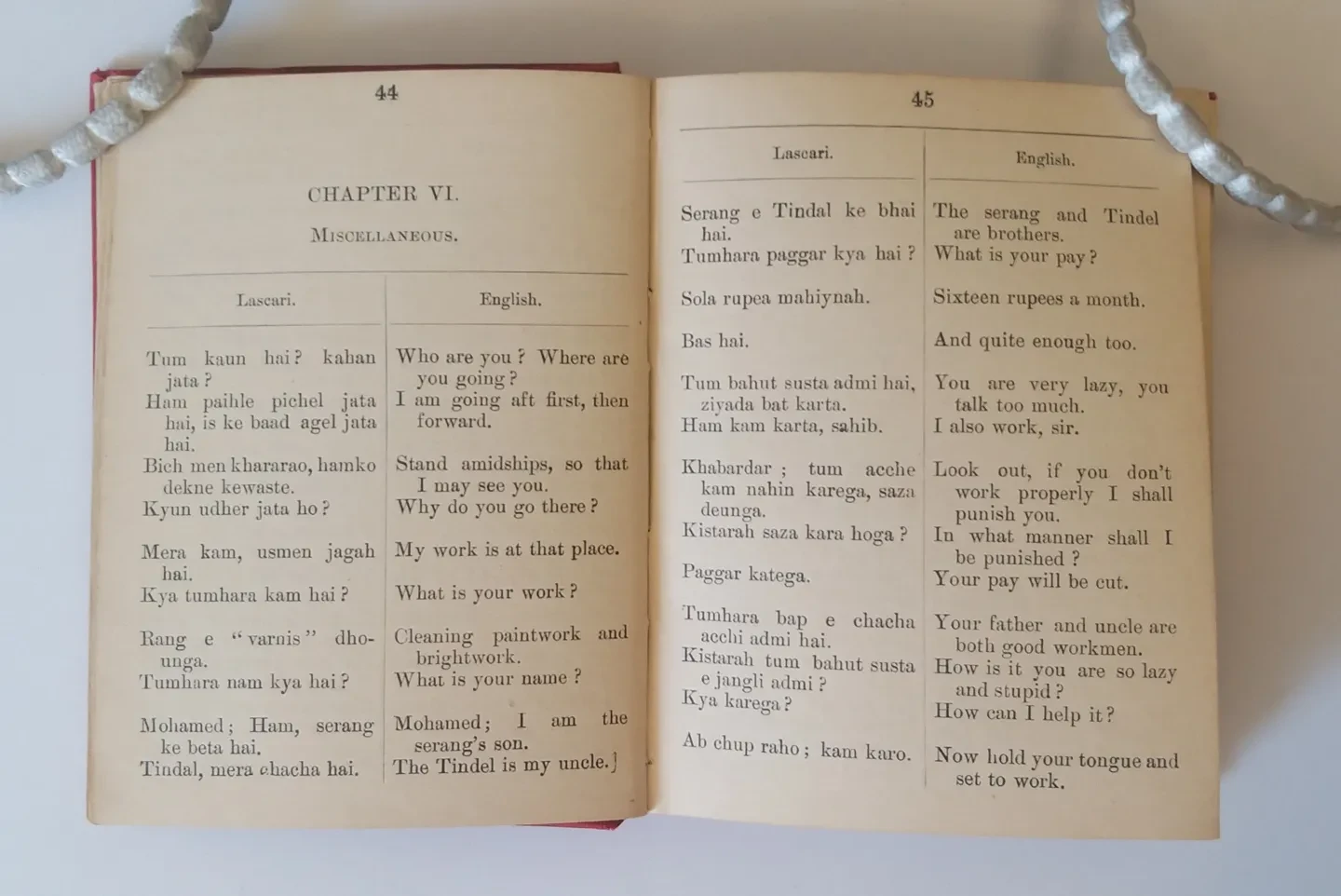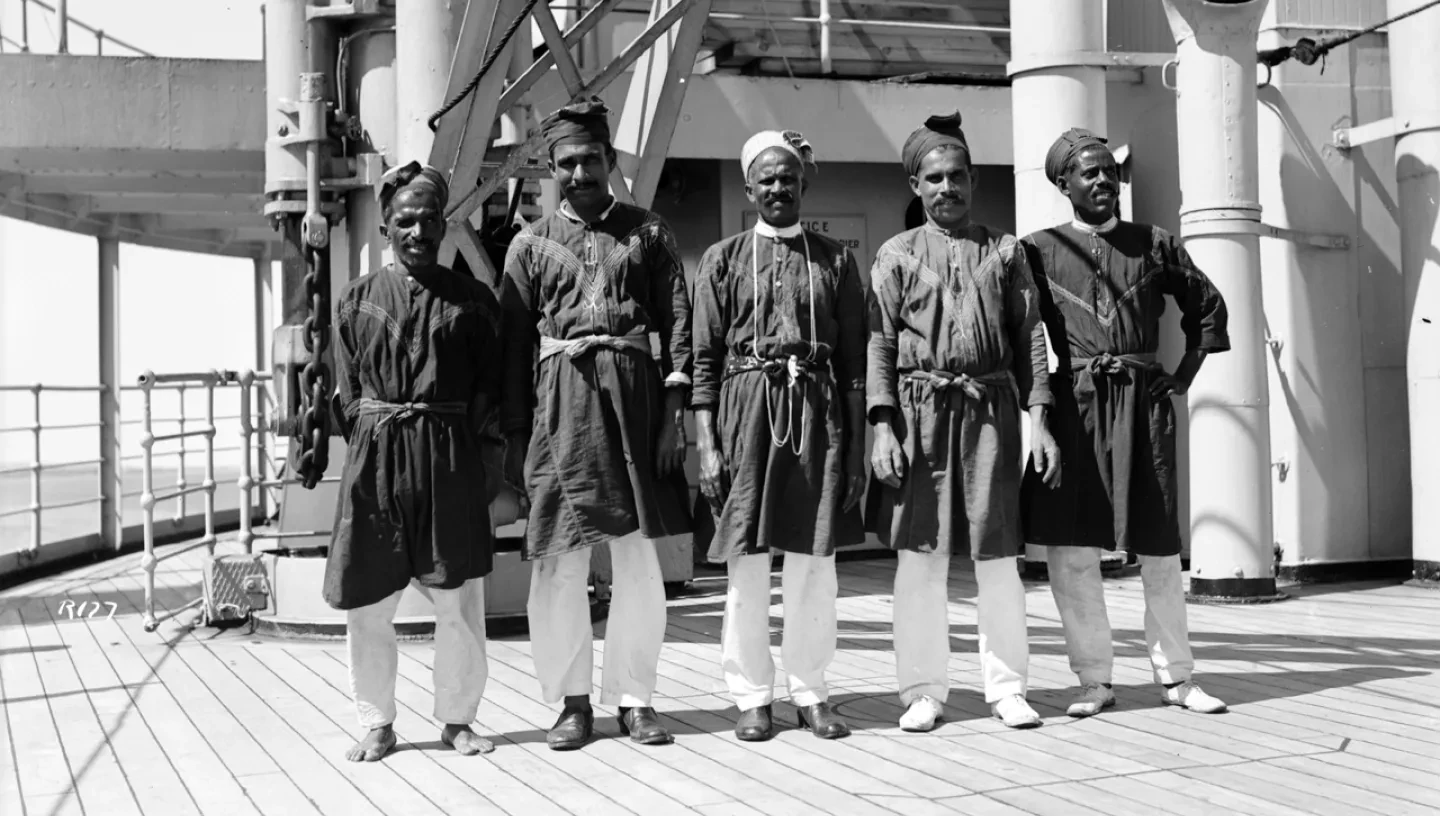
For over 200 years, British shipowners and companies have recruited sailors from the Indian Ocean region, more commonly known as lascars. These seamen have worked, fought and died on board British vessels yet have not always been given the recognition they deserve. The Caird Library and Archive holds phrasebooks which aimed to capture the language spoken by this diverse group of people serving on board European ships.
The Caird Library and Archive holds numerous maritime dictionaries describing the specialised terminology and jargons used on board Western ships throughout the ages. Such works allowed young seamen to ‘learn the ropes’ (get it?) or sailors to communicate better with their counterparts from other countries. Some are enormous compilations of hundreds and hundreds of pages, while others are precise and small enough to bring on any sea voyage.
Two of these phrasebooks in the Caird Library collection might be unassuming at first glance, but they allow us a glimpse into an important, albeit often overlooked part of maritime history: over two centuries of lascar employment on board British vessels.
One of them is Thomas Roebuck’s An English and Hindoostanee naval dictionary of technical terms and sea phrases; first published in 1811 during what is often termed the glorious age of sail.
The other, Lascari-bat: a collection of sentences used in the daily-routine of modern passenger steamers, where lascars are carried as the deck crew; also a copious English-Lascari vocabulary, was compiled nearly a century later by one A. L. Valentini during quite different times.
Defining lascars
To better understand these collection items, let’s first take a closer look at the lascars themselves.
Etymologically, the term originates from the Persian word for ‘army’ or ‘camp follower’ and was adapted by the Portuguese to the word lascarim to describe an Asian soldier or seaman.
That it was the Portuguese who first adapted this term does not come as too big a surprise. Ever since a safe sea route from Europe to India had been established, Portuguese captains were amongst the first to voyage to the Indian Ocean region and employ local seamen on a regular basis.
Eventually the British adopted the term as well and although it was widely used, it is crucial to remember that it was applied rather indifferently and loosely to any seamen recruited in the Indian Ocean region. Even the Portuguese ascribed the label lascarim to any locals recruited from ‘the Indies’, which they defined as the areas east of the Cape of Good Hope.
As European captains recruited from already culturally diverse port cities in various countries in the region, this meant that the men taken on as lascars did not come from a single ethnic, religious, cultural, or even linguistic group but spanned a multitude of ethnicities.
Today, the Oxford English Dictionary defines them as ‘East Indian Sailors’ and nowadays we associate the term with South Asian seamen who served on board European ships. But the issue of definition is not as simple as this, as the term was used as a rather broad label which, at times, also included East African, Middle Eastern, Filipino and Malay sailors – amongst others.
Early recruiting and regulations of lascar employment
The Portuguese were amongst the first to recruit lascars in large numbers throughout the sixteenth century, but the British were soon to follow.
Reportedly, the English East India Company even hired three Indian seamen in London for their very first voyage to India in 1614, who had likely made their way to Europe on board a Portuguese ship.
By the seventeenth century, the number of lascar sailors had become so great that the British parliament passed the Navigation Acts in 1651 to regulate international trade and commerce. Most significantly, these legislations limited the number of foreign sailors on board British ships to only one fourth of the crew.
There was but one exception: British ships returning from India. This decision seemed necessary as the crews of most ships making the long and gruelling journey around the Cape of Good Hope were regularly decimated by sickness, accidents and desertion. As it was nearly impossible to replace these sailors with European, let alone British, seamen, there was little other option than to recruit from lascar seamen instead.
In Indian port cities, lascars were often hired through local labour brokers called ghat serangs – meaning ‘wharf headmen’ – and they were hired and served as a group.
On board the ships, the lascars were overseen by a serang who served as something akin to a petty officer. Their main role was to ensure smooth communications between the lascars and the commanding officers as many Europeans lacked the language skills to communicate with their diverse crews. Not even all lascars on board the same ship would necessarily speak the same dialect or language and the serang was often the only person able to communicate with all officers and crew members.
Such diverse crews and related linguistic obstacles make it easy to understand why naval dictionaries and phrasebooks were highly regarded amongst officers of British shipping companies. One such example is Thomas Roebuck’s Naval dictionary.
Roebuck’s An English and Hindoostanee naval dictionary
Roebuck was born in Scotland in 1781 and learnt under linguist John Borth Gilchrist. In 1809 Roebuck decided to travel to Calcutta to join the East India Company but he must have been a passionate linguist as he spent his time on board the Larkins compiling a naval dictionary of his own.
His dictionary quickly proved popular after its initial publication in 1811 and multiple revised editions and reprints circulated well into the twentieth century.
In the preface of the 1813 edition, Roebuck summarises the importance and aim of his publication:
[…] although we have always been in the habit of employing many Native Seamen in our shipping, there is no work to be had, which is calculated to enable an Officer of a ship to give his orders, or carry on a conversation with the Lascars, upon the most common occurrences connected with his several duties.
A lascar language?
Although Roebuck insists that he had captured a naval language spoken by lascars based on Hindustani (‘Hindoostanee’) – and he even dedicates nearly one fourth of the book to simplified explanations of grammar, pronunciation, and syntax – it is questionable that there is, or ever was, an actual ‘lascari language'.
It has been pointed out in recent years that it is unlikely all lascars had been knowledgeable in Hindustani, due to their varied cultural backgrounds and linguistic origins. Instead, lascar crews might have used various languages and pidgins to communicate amongst each other and with the officers.
Furthermore, the idea of a ‘lascari language’ might be more simply understood as a European label ascribed to a collection of terms and phrases typically used on board Western ships manned by diverse groups of Asian sailors. Rather than a language spoken by people in their daily lives, it is a collection of naval commands – missing many crucial words which one would require in regular conversations and would expect in any other dictionaries or languages. Instead, it focuses on maritime terminology pertaining to the running of sea-faring vessels.
Nevertheless, the phrases and words captured by Roebuck reflect the diverse group of people who would have used them on board Western ships – drawing influence and adapting terms from multiple languages such as Hindustani, Arabic, Persian, Malay, and, of course, Portuguese and English.
It was even suggested that it was lascars who introduced many Portuguese-derived words into Indian languages. Take as an example the word balti which refers to a small, rounded cast-iron or steel pans with two handles. These pans can be commonly found in India, and even many Brits might recognise the term from curry houses and Indian restaurants where balti meat dishes are quite popular. The writer Amitav Gosh, amongst others, has speculated that the term was derived from the Portuguese word balde, which means bucket.
The age of steam
By the time Roebuck published his Naval dictionary, lascars had worked on board European sailing ships for many decades, but a new technological innovation in the mid-1800s would change their working conditions dramatically: steam power.
The work on board sailing ships was never without its dangers and required highly skilled crews with years of hands-on-deck experience, but, more so than training and skill, steam-powered vessels demanded seemingly insatiable amounts of coal.
With the large-scale introduction of steam, a hitherto unprecedented number of unskilled labourers was now needed to man the saloons, decks and engine rooms of the growing fleet of British merchant vessels, passenger liners and warships.
Valentini’s Lascari-bat
It was during these times that A. L. Valentini compiled Lascari-bat. Little is known about Valentini other than that he served in the Peninsular and Oriental Steam Navigation Company (P&O), one of the largest employers of lascars. The first edition was published in 1896, nearly a century after Roebuck’s naval dictionary, and the times and vessels on which lascars served had significantly changed.
Compared to Roebuck’s, Valentini’s phrasebook is very pragmatic in its structure and contents. For instance, it only contains two pages of conjugated verbs, ‘to give the reader some idea of the forms of verbs in their various moods and tenses.’ Valentini instead focused on phrases and vocabulary which he had deemed useful for working on board the ocean-faring vessels of his time.
While some commands such as ‘After six o’clock go aft’, ‘Hoist the Yard a little’ or ‘Scrub forward first’ seem reasonable and essential for the work on board a sea-faring vessel, but the phrasebook also includes phrases used to rebuke lascars.
Today, one might for instance question why a collection of ‘useful sentences used in the daily-routine of modern passenger steamers’ so readily included phrases such as ‘You are very lazy, you talk too much’; or ‘Sometimes you are alright, and sometimes perfectly stupid’.
As Valentini included such phrases of ‘daily-routine’, it could be argued that harsh language was all too commonly used by officers towards their subordinates. It is pertinent to point out though, that European officers generally thought of lascars as inferior, and this would have been reflected in how they spoke and communicated with them.
The language used toward lascars certainly would have reflected the socio-political circumstances of their time and likely would have been coloured by racially-loaded stereotypes and misconceptions of a wrongfully perceived European superiority – on board as well as on shore.
Lascars in Britain
By the time steam vessels had been introduced on a larger scale, the British public had already become aware of the growing numbers of lascars employed by British companies.
On board European ships, many lascar sailors had found their way to the British Isles but as the Navigation Acts restricted foreign sailors on outbound journeys, most shipping companies were unable or unwilling to rehire lascars for voyages to Asia.
Many lascars subsequently became destitute in British port cities and ended up in the streets and poor houses; some found their way back home – one way or another – while others settled in Britain, married and eventually made themselves a home.
At the same time, many British sailors saw their livelihoods threatened as the specialised regulations of lascar agreements, first introduced in the ‘Lascar Acts’ of 1832, allowed shipping companies to exploit their lascar crews. Most significantly by paying them lower wages and providing smaller, less comfortable lodging and fewer and less-nutritious provisions on board.
From the 1880s onwards, newly formed maritime unions organised protests and strike actions in Britain to voice their growing unrest but, despite the negative perception of and attitude towards them, the employment of lascars remained steady.
The end of an era
It was estimated that by the end of the First World War nearly one in five seamen on board British merchant vessels were lascars, but, although new technologies such as steam power had initially promoted their recruitment, the newest innovation in maritime shipping and warfare would now see to their downfall.
As many merchant vessels had been destroyed during the wars, new oil-powered vessels with significantly smaller crews were quickly replacing the endlessly coal-guzzling steam ships of the previous decades within just a few short years. With this, the number of lascars needed on board European ships also declined.
Eventually, during the time of growing calls for independence and efforts towards decolonisation after the wars, the Lascar Act was repealed in 1963 and it would be the last time the term lascar was used in British labour legislation.
Lascar crewmen had served, fought, and lost their lives on board European ships for more than two centuries and significantly contributed to making British merchant shipping and trading by sea possible, competitive, and eventually world domineering.
They served, often ill-treated, under-paid and under-fed in most difficult working conditions and could be considered one of the first, international migrant workforces – being recruited from multiple cultures and countries, serving on nationally-diverse ships and vessels while often not even speaking the same language as each other or their commanding officers.
The contributions of lascars to the success of Britain’s maritime empire had often been forgotten, deliberately overlooked, or downplayed in collective memory but they have found more, well-deserved acknowledgement in recent decades – and rightfully so.
To find out more about lascars, or to consult Roebuck’s and Valentini’s dictionary and phrasebooks in person, visit the Caird Library and Archive or browse our online catalogues.
Suggested reading
Balachandran, Gopalan. Globalizing labour? Indian seafarers and world shipping, c. 1870-1945. New Delhi: Oxford University Press, 2012. (RMG reference: PBH5938)
Ghosh, Amitav. ‘Of Fanas and Forecastles: The Indian Ocean and some lost languages of the Age of Sail’. In Economic and Political Weekly, June 21-27, 2008, Vol. 43(25): pp. 56-62. (This article can be accessed through our e-resource services at the Caird Library and Archive.)
Hyslop, Jonathan. ‘Steamship Empire: Asian, African and British Sailors in the Merchant Marine, c. 1880-1945’. In Journal of Asian and African Studies 2009, Vol. 44(1): pp.49-67.
Jaffer, Aaron. Lascars and Indian Ocean seafaring, 1780-1860: shipboard life, unrest and mutiny. Woodbridge: The Boydell Press, 2015. (RMG reference: PBH7368)
Visram, Rosina. Ayahs, Lascars and princes: Indians in Britain 1700-1947. London: Pluto Press, 1986. (RMG reference: PBH0627)

